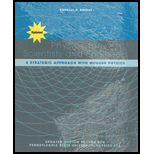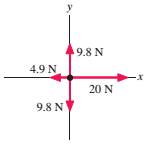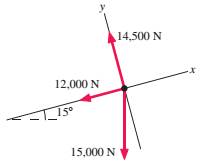
PHYS 212 FOR SCI+ENG W/MAST PHYS >ICP<
1st Edition
ISBN: 9781323834831
Author: Knight
Publisher: PEARSON C
expand_more
expand_more
format_list_bulleted
Concept explainers
Textbook Question
Chapter 6, Problem 68EAP
Problems 68 and 69 show a free-body diagram. For each:
a. Write a realistic dynamics problem for which this is the correct free-body diagram. Your problem should ask a question that can be answered with a value of position or velocity (such as "How far?" or "How fast?"), and should give sufficient information to allow a solution.
b. Solve your problem!
68.
FIGURE P6.68

69.
FIGURE P6.69

Expert Solution & Answer
Want to see the full answer?
Check out a sample textbook solution
Students have asked these similar questions
No chatgpt pls
Consider the situation in the figure below; a neutral conducting ball hangs from the ceiling by an insulating string, and a charged insulating rod is going to be placed nearby.
A. First, if the rod was not there, what statement best describes the charge distribution of the ball?
1) Since it is a conductor, all the charges are on the outside of the ball. 2) The ball is neutral, so it has no positive or negative charges anywhere. 3) The positive and negative charges are separated from each other, but we don't know what direction the ball is polarized. 4) The positive and negative charges are evenly distributed everywhere in the ball.
B. Now, when the rod is moved close to the ball, what happens to the charges on the ball?
1) There is a separation of charges in the ball; the side closer to the rod becomes positively charged, and the opposite side becomes negatively charged. 2) Negative charge is drawn from the ground (via the string), so the ball acquires a net negative charge. 3)…
answer question 5-9
Chapter 6 Solutions
PHYS 212 FOR SCI+ENG W/MAST PHYS >ICP<
Ch. 6 - Are the objects described here in equilibrium...Ch. 6 - A ball tosses straight up has v = 0 at its highest...Ch. 6 - Kat, Matt, and Nat are arguing about why a physics...Ch. 6 - If you know all of the forces acting on a moving...Ch. 6 - An elevator, hanging from a single cable, moves...Ch. 6 - An elevator, hanging from a single cable, moves...Ch. 6 - Are the following statements true or false?...Ch. 6 -
8. An astronaut takes his bathroom scale to the...Ch. 6 -
9. The four balls in FIGURE Q6.9 have been...Ch. 6 - Prob. 10CQ
Ch. 6 - Prob. 11CQCh. 6 - A hand presses down on the book in FIGURE Q6.12....Ch. 6 - Boxes A and B in FIGURES Q6.13 both remain at...Ch. 6 - Suppose you push a hockey puck of mass m across...Ch. 6 - A block pushed along the floor with velocity...Ch. 6 - A crate of fragile dishes is in the back of a...Ch. 6 - Five balls move through the air as shown in FIGURE...Ch. 6 - The three ropes in FIGURE EX6.1 are tied to a...Ch. 6 - The three ropes in FIGURE EX6.2 are tied to a...Ch. 6 - A football coach sits on a sled while two of his...Ch. 6 - A 20 kg loudspeaker is suspended 2.0 m below the...Ch. 6 - A 65 kg gymnast wedges himself between two closely...Ch. 6 - A construction worker with a weight of 850 N...Ch. 6 - In an electricity experiment, a 1.0 g plastic ball...Ch. 6 - The forces in FIGURE EX6.8 act on a 2.0 kg object....Ch. 6 - The forces in FIGURE EX6.9 act on a 2.0 kg object....Ch. 6 - FIGURE EX6.10 shows the velocity graph of a 2.0 kg...Ch. 6 - FIGURE EX6.11 shows the force acting on a 2.0 kg...Ch. 6 - A horizontal rope is tied to a 50 kg box on...Ch. 6 - A 50 kg box hangs from a rope. What is the tension...Ch. 6 - A 2.0 × 107 kg train applies its brakes with the...Ch. 6 - A 8.0 × 104 kg spaceship is at rest in deep space....Ch. 6 - The position of a 2.0 kg mass is given by x = (2t3...Ch. 6 - A woman has mass of 55 kg. a. What is her weight...Ch. 6 - It takes the elevator in a skyscraper 4.0 s to...Ch. 6 - Zach, whose mass is 80 kg, is in an elevator...Ch. 6 - What thrust does a 200 g model rocket need in...Ch. 6 - What thrust does a 200 g model rocket need in...Ch. 6 - A 20,000 kg rocket has a rocket motor that...Ch. 6 - The earth is 1.50 × 1011 m from the sun. The...Ch. 6 - Bonnie and Clyde are sliding a 300 kg bank safe...Ch. 6 - A stubborn, 120 kg mule sits down and refuses to...Ch. 6 - A 10 kg crate is placed on a horizontal conveyor...Ch. 6 - Bob is pulling a 30 kg filing cabinet with a force...Ch. 6 - A rubber-wheeled kg cart rolls down a 15° concrete...Ch. 6 - A 4000 kg truck is parked on a 15° slope. How big...Ch. 6 - A 1500 kg car skids to a halt on a wet road where...Ch. 6 - A 50,000 kg locomotive is traveling at 10 m/s when...Ch. 6 - You and your friend Peter are putting new shingles...Ch. 6 - An Airbus A320 jetliner has a takeoff mass of...Ch. 6 -
34. A medium-sized jet has a 3.8-m-diameter...Ch. 6 - A 75 kg skydiver can be modeled as a rectangular...Ch. 6 - A 6.5-cm-diameter ball has a terminal speed of 26...Ch. 6 - A 2.0 kg object initially at rest at the origin is...Ch. 6 - A 5.0 kg object initially at rest at the origin is...Ch. 6 - The 1000 kg steel beam in FIGURE P6.39 is...Ch. 6 - Henry, whose mass is 95 kg, stands on a bathroom...Ch. 6 - An accident victim with a broken leg is being...Ch. 6 - Seat belts and air bags save lives by reducing the...Ch. 6 - The piston of a machine exerts a constant force on...Ch. 6 - Compressed air is used to fire a 50 g ball...Ch. 6 - a. A rocket of mass m is launched straight up with...Ch. 6 - A rifle with a barrel length of 60 cm fires a 10 g...Ch. 6 - A truck with a heavy load has a total mass of 7500...Ch. 6 - An object of mass m is at rest at the top of a...Ch. 6 - Prob. 49EAPCh. 6 - A baggage handler drops your 10 kg suitcase onto a...Ch. 6 - A 2.0 kg wood block is launched up a wooden ramp...Ch. 6 - It’s a snowy day and you're pulling a friend along...Ch. 6 - A large box of mass M is pulled across a...Ch. 6 - Prob. 54EAPCh. 6 - You're driving along at 25 m/s with your aunt's...Ch. 6 - The 2.0 kg wood box in FIGURE P6.56 slides down a...Ch. 6 - A 1.0 kg wood block is pressed against a vertical...Ch. 6 - A person with compromised pinch strength in his...Ch. 6 - A ball is shot from a compressed-air gun at twice...Ch. 6 - Starting from rest, a 2500 kg helicopter...Ch. 6 - Astronauts in space "weigh" themselves by...Ch. 6 - A particle of mass m moving along the x-axis...Ch. 6 - At t = 0, an object of mass m is at rest at x = 0...Ch. 6 - At t = 0, an object of mass m is at rest at x = 0...Ch. 6 - Prob. 65EAPCh. 6 - A 60 kg skater is gliding across frictionless ice...Ch. 6 - Prob. 67EAPCh. 6 - Problems 68 and 69 show a free-body diagram. For...Ch. 6 - Problems 68 and 69 show a free-body diagram. For...Ch. 6 - Prob. 70EAPCh. 6 - In Problems 70 through 72 you are given the...Ch. 6 - In Problems 70 through 72 you are given the...Ch. 6 - A block of mass m is at rest at the origin at t =...Ch. 6 - A spring-loaded toy gun exerts a variable force on...Ch. 6 - FIGURE CP6.7S shows an accelerometer, a device for...Ch. 6 - An object moving in a liquid experiences a linear...Ch. 6 - Prob. 77EAPCh. 6 - An object with cross section A is shot...
Knowledge Booster
Learn more about
Need a deep-dive on the concept behind this application? Look no further. Learn more about this topic, physics and related others by exploring similar questions and additional content below.Similar questions
- AMPS VOLTS OHMS 5) 50 A 110 V 6) .08 A 39 V 7) 0.5 A 60 8) 2.5 A 110 Varrow_forwardThe drawing shows an edge-on view of two planar surfaces that intersect and are mutually perpendicular. Surface (1) has an area of 1.90 m², while surface (2) has an area of 3.90 m². The electric field in the drawing is uniform and has a magnitude of 215 N/C. Find the magnitude of the electric flux through surface (1 and 2 combined) if the angle 8 made between the electric field with surface (2) is 30.0°. Solve in Nm²/C 1 Ө Surface 2 Surface 1arrow_forwardPROBLEM 5 What is the magnitude and direction of the resultant force acting on the connection support shown here? F₁ = 700 lbs F2 = 250 lbs 70° 60° F3 = 700 lbs 45° F4 = 300 lbs 40° Fs = 800 lbs 18° Free Body Diagram F₁ = 700 lbs 70° 250 lbs 60° F3= = 700 lbs 45° F₁ = 300 lbs 40° = Fs 800 lbs 18°arrow_forward
- PROBLEM 3 Cables A and B are Supporting a 185-lb wooden crate. What is the magnitude of the tension force in each cable? A 20° 35° 185 lbsarrow_forwardThe determined Wile E. Coyote is out once more to try to capture the elusive Road Runner of Loony Tunes fame. The coyote is strapped to a rocket, which provide a constant horizontal acceleration of 15.0 m/s2. The coyote starts off at rest 79.2 m from the edge of a cliff at the instant the roadrunner zips by in the direction of the cliff. If the roadrunner moves with constant speed, find the minimum velocity the roadrunner must have to reach the cliff before the coyote. (proper sig fig in answer)arrow_forwardPROBLEM 4 What is the resultant of the force system acting on the connection shown? 25 F₁ = 80 lbs IK 65° F2 = 60 lbsarrow_forward
- Three point-like charges in the attached image are placed at the corners of an equilateral triangle as shown in the figure. Each side of the triangle has a length of 38.0 cm, and the point (C) is located half way between q1 and q3 along the side. Find the magnitude of the electric field at point (C). Let q1 = −2.80 µC, q2 = −3.40 µC, and q3 = −4.50 µC. Thank you.arrow_forwardSTRUCTURES I Homework #1: Force Systems Name: TA: PROBLEM 1 Determine the horizontal and vertical components of the force in the cable shown. PROBLEM 2 The horizontal component of force F is 30 lb. What is the magnitude of force F? 6 10 4 4 F = 600lbs F = ?arrow_forwardThe determined Wile E. Coyote is out once more to try to capture the elusive Road Runner of Loony Tunes fame. The coyote is strapped to a rocket, which provide a constant horizontal acceleration of 15.0 m/s2. The coyote starts off at rest 79.2 m from the edge of a cliff at the instant the roadrunner zips by in the direction of the cliff. If the roadrunner moves with constant speed, find the minimum velocity the roadrunner must have to reach the cliff before the coyote. (proper sig fig)arrow_forward
- Hello, I need some help with calculations for a lab, it is Kinematics: Finding Acceleration Due to Gravity. Equations: s=s0+v0t+1/2at2 and a=gsinθ. The hypotenuse,r, is 100cm (given) and a height, y, is 3.5 cm (given). How do I find the Angle θ1? And, for distance traveled, s, would all be 100cm? For my first observations I recorded four trials in seconds: 1 - 2.13s, 2 - 2.60s, 3 - 2.08s, & 4 - 1.95s. This would all go in the coloumn for time right? How do I solve for the experimental approximation of the acceleration? Help with trial 1 would be great so I can use that as a model for the other trials. Thanks!arrow_forwardAfter the countdown at the beginning of a Mario Kart race, Bowser slams on the gas, taking off from rest. Bowser get up to a full speed of 25.5 m/s due to an acceleration of 10.4 m/s2. A)How much time does it take to reach full speed? B) How far does Bowser travel while accelerating?arrow_forwardThe drawing in the image attached shows an edge-on view of two planar surfaces that intersect and are mutually perpendicular. Side 1 has an area of 1.90 m^2, Side 2 has an area of 3.90 m^2, the electric field in magnitude is around 215 N/C. Please find the electric flux magnitude through side 1 and 2 combined if the angle (theta) made between the electric field with side 2 is 30.0 degrees. I believe side 1 is 60 degrees but could be wrong. Thank you.arrow_forward
arrow_back_ios
SEE MORE QUESTIONS
arrow_forward_ios
Recommended textbooks for you
 Physics for Scientists and Engineers: Foundations...PhysicsISBN:9781133939146Author:Katz, Debora M.Publisher:Cengage Learning
Physics for Scientists and Engineers: Foundations...PhysicsISBN:9781133939146Author:Katz, Debora M.Publisher:Cengage Learning University Physics Volume 1PhysicsISBN:9781938168277Author:William Moebs, Samuel J. Ling, Jeff SannyPublisher:OpenStax - Rice University
University Physics Volume 1PhysicsISBN:9781938168277Author:William Moebs, Samuel J. Ling, Jeff SannyPublisher:OpenStax - Rice University Physics for Scientists and Engineers, Technology ...PhysicsISBN:9781305116399Author:Raymond A. Serway, John W. JewettPublisher:Cengage Learning
Physics for Scientists and Engineers, Technology ...PhysicsISBN:9781305116399Author:Raymond A. Serway, John W. JewettPublisher:Cengage Learning Principles of Physics: A Calculus-Based TextPhysicsISBN:9781133104261Author:Raymond A. Serway, John W. JewettPublisher:Cengage Learning
Principles of Physics: A Calculus-Based TextPhysicsISBN:9781133104261Author:Raymond A. Serway, John W. JewettPublisher:Cengage Learning College PhysicsPhysicsISBN:9781938168000Author:Paul Peter Urone, Roger HinrichsPublisher:OpenStax College
College PhysicsPhysicsISBN:9781938168000Author:Paul Peter Urone, Roger HinrichsPublisher:OpenStax College Physics for Scientists and Engineers with Modern ...PhysicsISBN:9781337553292Author:Raymond A. Serway, John W. JewettPublisher:Cengage Learning
Physics for Scientists and Engineers with Modern ...PhysicsISBN:9781337553292Author:Raymond A. Serway, John W. JewettPublisher:Cengage Learning

Physics for Scientists and Engineers: Foundations...
Physics
ISBN:9781133939146
Author:Katz, Debora M.
Publisher:Cengage Learning

University Physics Volume 1
Physics
ISBN:9781938168277
Author:William Moebs, Samuel J. Ling, Jeff Sanny
Publisher:OpenStax - Rice University

Physics for Scientists and Engineers, Technology ...
Physics
ISBN:9781305116399
Author:Raymond A. Serway, John W. Jewett
Publisher:Cengage Learning

Principles of Physics: A Calculus-Based Text
Physics
ISBN:9781133104261
Author:Raymond A. Serway, John W. Jewett
Publisher:Cengage Learning

College Physics
Physics
ISBN:9781938168000
Author:Paul Peter Urone, Roger Hinrichs
Publisher:OpenStax College

Physics for Scientists and Engineers with Modern ...
Physics
ISBN:9781337553292
Author:Raymond A. Serway, John W. Jewett
Publisher:Cengage Learning
Newton's Third Law of Motion: Action and Reaction; Author: Professor Dave explains;https://www.youtube.com/watch?v=y61_VPKH2B4;License: Standard YouTube License, CC-BY